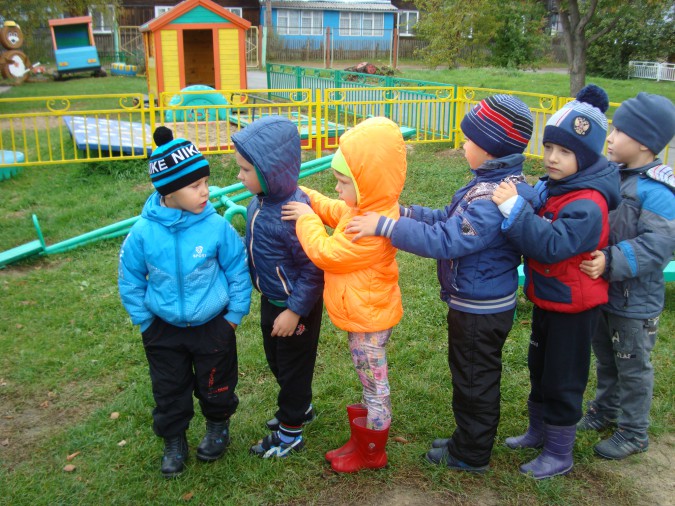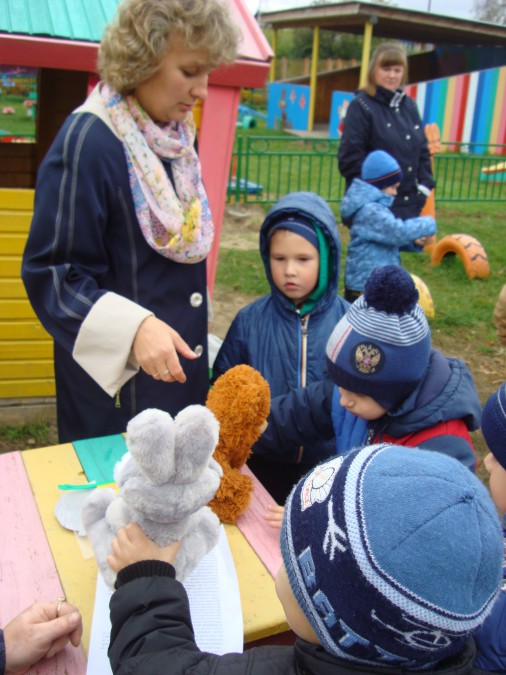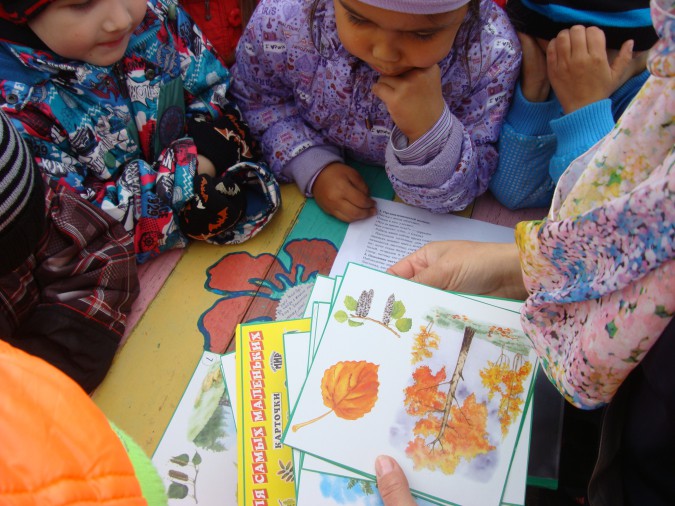Autumn walk in senior group DOW
Author: Shishkovskaya Irina Ivanovna,educator of the senior group of compensatory orientation MBDOU "TsRR-d / s" Chaika "of Abakan.
Material Description: the proposed summary will be useful to kindergarten teachers, methodologists and senior educators, teachers primary school, educators of extended day groups and parents.
Outline plan autumn walk in the senior group kindergarten.
Topic: "In the autumn meadow."
Target: creating conditions for fixing the signs of autumn through a walk-journey to a forest clearing.
Tasks:
- contribute to the expansion of children's knowledge about the characteristic signs of autumn, emphasizing the beauty of autumn nature and the variety of colors;
- create conditions for encouraging children to speech activity;
- to promote the development of observation, education of curiosity and love for the native nature;
-create conditions for research activities;
- to form an idea of the importance of work, to teach to carry out the work begun to the end;
-create conditions for the organization of motor activity.
Materials and equipment: buckets, children's rakes, brooms, outdoor games, sandbags, whistle, chalk, ball, hoops, weathercocks, tape recorder with autumn melodies.
The course of the walk.
Breathing exercises.
Educator:
-Guys, how good it is outside. Let's get some fresh air and clean our noses.
(3 times a deep breath through the nose - exhale through the mouth, lips folded into a "tube")
Educator:
- Guess the riddle:
Don't trust the warm sun
Blizzard ahead.
In a golden circle
Leaves flew.
I came with the rain
Leaf fall and winds. (Autumn)
-Guys, what signs of autumn are mentioned in this riddle? (leaf fall, rain, wind.)
What does "leaf fall" mean?
-Do you like autumn?
Echo game (with ball)
Description of the game: children stand in a circle, inside the circle is a teacher with a ball. The teacher throws the ball to the child and says a sign, and the child returns the ball to the teacher and adds an object to the sign. Example: autumn weather, autumn rain, autumn boots, autumn sky, etc.
Educator:
-Today they brought me a letter from Bunny-Dunno. He lives in the forest, and writes that autumn is his favorite time of the year and, therefore, he wrote a story about it. Listen:
Autumn is the most beautiful time of the year. It happens in July and August. The sun is very hot, and the birds fly from warm lands. Green leaves are blooming on the trees. Mother blooms - and - stepmother and lungwort. There is a lot of snow in the forest.
-Guys, do you agree with Bunny - Dunno?
-Let's capture everything you just said in the drawings.
Drawings on the pavement to the autumn melody.

Therefore, the theme of the program of the year is "The Five Senses". Since we believe that art and creativity are more and more sensitive, let's turn to the senses. We are alert and we want to warn you! Let's listen, and also what seems unintelligible to us, we will touch, feel and tremble, we will taste, taste and taste what Art gives us. 3.
In the greenhouse of the Botanical Garden, we are an appeal to the senses by Nuno Alexim. This exhibition, which is open throughout the year, is the result of an invitation from this artist to work with garden materials. The small shows of the Municipal Art Collection are taking place this year in the renovated reading room of our Documentation and Research Center. With this exhibition, the Cistern is a place for olfactory artistic enjoyment. Commissioner Miguel Matos brought an excerpt from this book to a group of olfactory artists of the author's perfumery so that they could feel the words and translate the sensations caused by smells.
Educator:
-Guys, most often in your drawings you depicted autumn leaves.
Didactic game "2 red sheets and 2 yellow sheets".
Game progress.
Educator:
- I will say: “I have 2 red sheets”, and you say: “And I have 2 yellow sheets”.
… I don’t have two red leaves - …
... I leaned over two red leaves - ...
... I admire two red leaves - ...
... I remember two red leaves - ...
Cognitive - research activities - the study of wind power. Experience "Hello, wind."
-Children, tell me, when the leaves are spinning, flying, who helps them? (wind)
- Do you want to turn into a breeze? (Yes)
The teacher suggests taking the leaves in your hands, lifting them over your head and blowing hard. Leaves flutter and swirl.
Educator:
-Children, this is how a light breeze blows. But if a very strong wind blows, then the leaves spin strongly and fly above the ground for a long time.
The teacher suggests lifting the leaves above your head and blowing hard. Leaves flutter and swirl.
Mobile game "Wind-breeze".
Children stand in a circle. The leader is chosen by the counting room - "Breeze". Children move in a circle with the words:
"The wind in the park turns the leaves,
Circling in the sky, circling in puddles.
He throws them at our feet,
And on wet roads.
Come on, breeze, breeze
Stain the sheet quickly."
After the end of the words, the child - "breeze" catches up with the rest of the children.
The game is repeated 3-4 times.
Educator:
Autumn is golden
Came to us again
Let's collect the leaves
and let's go for a walk
- I have leaves in my hands, what tree do you think they come from?
How do they differ from each other? (research activity)
The game "Do not stand still, build around ______ round dance"
(we call the trees that grow on the group plot)
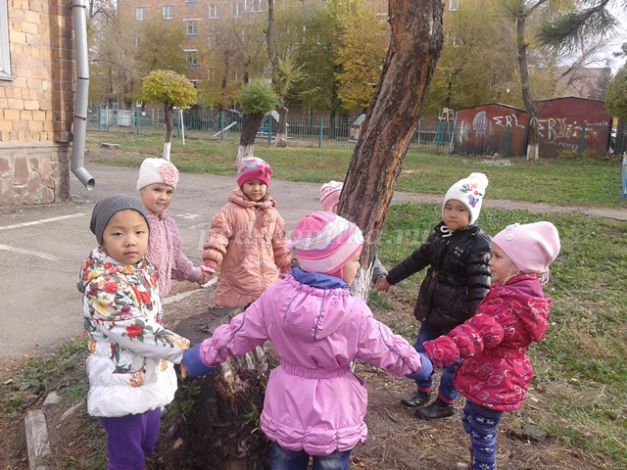
Educator:
- It often rains in autumn.
Outdoor game: "Sun and rain."
The children say the words in chorus:
The sun shone in the sky
We got a lot of fun.
There is loud laughter
The sun shines for everyone.
(children walk, dance on the site)
A cloud suddenly covered the sun
It became sad and depressing.
The pouring rain poured down,
We ran home.
(children run under the roof or under the umbrella)
Sedentary game "Au"
The driver is selected, he closes his eyes. Children walk in a circle and say the words:
Vanya, you are in the forest now
You don't open your eyes
who called you - find out.
At this time, the teacher touches the child and he says "AU". The driver must call him by name. If he guesses, then he becomes the driver.
Labor activity:
Educator:
- Guys, what do you think, why do we need cleanliness on the site? Why does the janitor sweep the trash? (Answers of children). Look at our site: clean or dirty? (Answers of children). And what will happen if we play on such a dirty site? (Answers of children). What should we do to be healthy? (Answers of children).
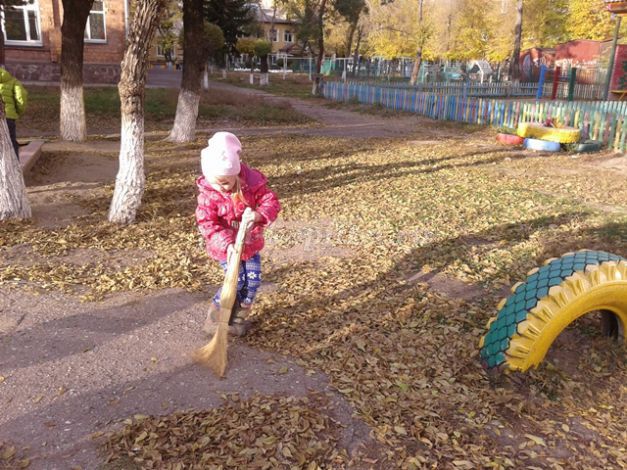
This artistic installation is the result of this challenge that crosses the universes of art, philosophy and scent. A synesthetic and full body experience, through a sensory channel little known in the world of plastic arts, smell. Invited to hold an exhibition in the art floor greenhouse, Nuno Alexim refers to the senses and uses materials from this Botanical Garden. Each niche of the Greenhouse House is dedicated to meaning, thanks to eye-catching minimalist graphic work. climbing plants, edible flowers, herbs, spices, wool, strings and various textures take the visitor to discover which of the five senses is represented in the work you see, also makes this site work specific work, which develops during the year, after the seasons.

Independent motor-play activity:
hand walk,
running "snake" between the trees,
games with remote material (hoops, weathercocks),
games "Harvest" (throwing sandbags in a bucket)
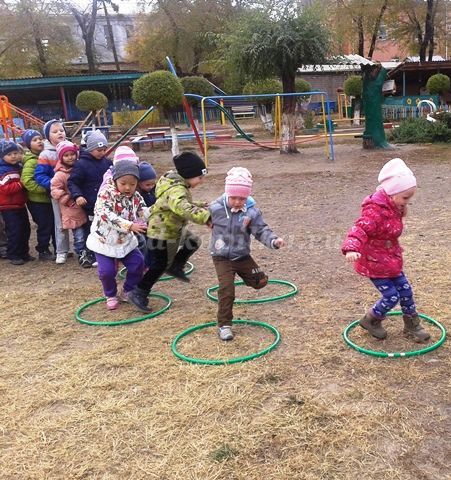
We invite you to see this exhibition, leaving mesmerized by the minimalism of rosemary patterns and feeling the desire to smell, hear, taste, touch, look, feel! An exhibition with drawings, installations and works of a sculptural nature, the exhibition will give the key to the discussion of war and fear; sleep and dreams, the hopes placed on the child and the fears that arise from them; the importance of others and the urgency of the embrace; celebration Everyday life; the necessity and possibility of contemplation; threats and survival of nature; beauty and memory and representation of nature; the body as a place of knowledge and violence, life and death.
Individual work
“Find and name the right word” (the teacher invites the child to highlight and name only those words that have the sound C (leaf, pine, sand, rope, leaf fall, autumn, etc.)
Elena Susolina
From birth, the child is a discoverer, a researcher of the world that surrounds him, and therefore the organization walks with children opens up huge potential opportunities for the comprehensive development of the child's personality. Exactly on walk preschoolers are provided with unique conditions for comprehensive development, their needs are fully satisfied for active movements, for independent actions when getting acquainted with the outside world, for getting new and vivid impressions, for free play, both with toys and natural material. Preschoolers love walks, because on the street you can jump, run, ride bicycles and sleds, observe natural phenomena, flowers, birds and note the characteristic signs of each season and each time admire the beauty of the world around. On the walks children learn the world in all its glory, strengthen their health, observe, reflect, experiment. Exactly stroll provides a great opportunity not only to improve the health of preschoolers, but also to enrich them with various knowledge, contributes to the development of observation, attention, memory, and thinking. Planning a variety of activities for walk allows you to nurture love and careful attitude to the natural environment.
The exhibition opens on the day the festival is presented to the public and is clear throughout the summer. We invite you to discover a space that, in addition to its function, will evoke new imaginary ideas and awaken feelings, offering a new perception of the boundaries of its physical dimension, transporting us to the external context and reversing the obvious: when we enter the interior, we go out.
Welcome appears as an extension of the garden within the House, being an amazing sensory experience. 8. Starting from central theme five senses and succession to the exhibition of works of the municipal art collection, we presented during the year in reading room three works framed by a theme.
In order to walks children and contributed to the comprehensive development, and not become boring, it is necessary to plan a variety of activities, use a variety of games and observations. That's why stroll consists of 5 constituents: observation, outdoor game, plot - role-playing game, labor, individual work with kids. Since the game is the leading activity of the preschooler, therefore, all activities are organized in game form and corresponds to a certain topics.
Offering touch and hearing, in volumes and cutouts, this piece is still aware of the existence of multiple degrees of blindness. We can find them in the balance of colors and lines, in the tensions we feel between shapes, in the light and darkness that colors convey. This work by Sofia Areal shows us how seemingly simple elements evoke feelings of joy, freshness or inspire moments of reflection.
This year we have invited the artist João Diaz to develop the work in an open studio, using the Cistern as an area of inspiration and intervention, with the Five Senses as its central theme. Within two weeks, in May, Joao Diaz will create a work in the Cistern, which will be visible before the end of the year. It challenges artists to create works that can be created in the context of the House, which reflect the inspiration in it, in its gardens and in the territory in which it is inserted, starting from a theme or problematic.
The purpose of this walks:
To form and consolidate children's knowledge about autumn changes occurring in nature.
To develop speed in running in children, to cultivate endurance (start running only after the end of the words); ability to plan; cognitive interest; desire to interact in the game with each other. To instill in children the habit of maintaining cleanliness and order in the kindergarten area, the desire to work for the common good.
In the conservatory, Nuno Alexim's exhibition evokes all the senses, also using materials from this garden. It is a source of inspiration in oriental art for its elegance and symbolism associated with generosity. Bamboo shoots are highly valued in cooking.
Its stems, of very varied sizes, were used as musical instrument different civilizations. Each plot is dedicated to meaning, using inert plants and materials to stimulate it. flower beds are crossed by small paths to travel and from which you are invited to smell, taste, sound, touch, color of different materials.
Integration of educational regions:
"Cognitive Development", « Speech development» , « Physical development» , "Social - communicative".
preliminary work:
Related conversations autumn, reading poems, guessing riddles, looking at illustrations.
All parts walks were interconnected and clearly marked: observation, work, outdoor game, role-playing game, individual work with children. For the comprehensive development of children, I used the following materials and equipment: children's dishes for working in a cafe, a first-aid kit for working in a first-aid post, pictures depicting trees and vegetables. All equipment was practical. She constantly turned to the existing knowledge and experience of the children, giving them the opportunity to independently complete the task. During walks used a variety of methods and we: verbal - riddles, poem, conversation word game "What tree leaf"; visual, observation didactic game "Find the extra in each chain"; practical - collection autumn leaves for autumn crafts; game methods - mobile and plot - role-playing games. Used the front subgroup and individual forms of organization of children's activities. The children were interested throughout walks.
In each session, scientific illustrator Sarah Simones, host of this workshop, challenges lovers of inspiration from the House's Botanical Garden, its plants, landscape and all its elements. This exhibition presents a number of works that were carried out in the course of this activity.
This volunteer program intends to provide free time activities for people interested in the art of gardening. Schedule from January to May: from 10 to 12 and from 2 to 4. Time from June to September: from 10 to 12. If you have free time, come and try these seminars, which are held every year in May. The botanical garden is decorated with flowers and updated to host these five sessions, which test the production techniques for painting materials from garden plants. In these lessons we will play with different plants, including papyrus.
Walk progress:
Children in pairs go to the site.
1. Organizational moment.
Leaves fall off the branches,
Birds fly south.
"What time of year?"- ask.
We will be answered: "This." (autumn)
caregiver: Guys, what time of year is it? What month? (children's answers)
caregiver: Guys, how did you determine what happened autumn on what grounds? (children's answers)
We will produce paints and paint, develop some alternative methods. Enrollment required. The meeting with the artists or about the plants takes place on time, giving us the opportunity to learn more about the styles presented or about the life and work of the artist. These are sessions that also offer a free conversation between speakers and participants.
The three moments of exchange distributed over the course of the year will concern the five senses, starting with some of the plants in the Garden, linking them to artistic, scientific, historical and literary aspects. Exhibition Putting the body to think Putting the body to think is an exhibition that starts from philosophy to get to angle, smell and olfactory art. Curator Miguel Matos explains the concept and why perfume can be contemporary art. Perfumer Lucas Gracia showcases the vegetable and animal kingdoms, giving scents of amazing raw materials.
caregiver A: Right guys. Cold days have come, it has become windy, it often rains; leaves on trees change color from green to yellow, orange, red, crimson; leaf fall begins; insects hid; migratory birds fly south; the nights became longer and the days short; people harvest from fields, vegetable gardens and orchards; you need to dress warmer when you go out, because it got cold;
Duration: 1 hour. Recipients: young and adults. Venue: Auditorium Free. In this conversation, we will look at the importance of aromas in the perception of the world around us and smell as a trigger for ancient memories. It will have a practical component where he will demonstrate the importance of flavors in judging food and where each participant will prepare personalized perfumes. Orientation: João Paulo Noronha Duration: 2 hours Target: adults Venue: auditorium Maximum amount participants: 14 Free.
2. The main part.
tree watching autumn.
leaf fall, leaf fall,
The yellow leaves are flying.
Yellow maple, yellow beech,
Yellow circle in the sky.
Yellow yard, yellow house.
The whole earth is yellow all around.
yellowness, yellowness,
Means, autumn is not spring.
V. Nirovich
caregiver: How trees change with the onset autumn? (children's answers)
In this program we find a varied offer of initiatives for school audiences and organized groups, from visits, visits to games and workshops dedicated to exhibition patents and gardens, adapted to every level of education. It is designed for everyone who loves to draw and does not require any training in the area.
Holidays of school art in spring and summer - a good choice for those who have children from 6 to 12 years old. In summer, the offer also applies to young people from 13 to 17 years old. Visit one of the exhibits of patents that meet the interests of the group. Talk to us and help us reach our goal.
caregiver: What is the name of phenomenon: "subsidence autumn leaves» ? (children's answers)
caregiver: What colors are autumn leaves ? (children's answers)
caregiver: Do you think all the trees have changed? (children's answers)
caregiver: No, not all trees have changed. Conifers trees: spruce, pine, cedar do not shed their needles for the winter, but remain the same green.
Every piece of art opens up a world of possibilities. Through various expressive modalities, we will try different exercises of creative interpretation with the aim of bringing out each artist's universe and expanding our own. It was developed to facilitate the design of observations, allowing anyone to embody the apparent reality in two dimensions with precision in size and perspective. Vine from which coal is produced; linen and cotton from which fibers are extracted to make canvases, reddish-red dyes from which red is obtained are examples of the look that can be seen in this space.
This fashionista is forest
Often changes his outfit:
In a white coat - in winter,
All in earrings - in the spring,
Green sundress - in summer,
In a day autumn - dressed in a raincoat.
If the wind blows
The golden cloak rustles.
I. Semenova
caregiver: Guys, what do you think about which tree I read the poem? (children's answers)
Secondary, collegiate and senior. Interesting visit to the garden and its botanical species. Want to know how this botanical garden works and why? From those plants that we find, we will know some of the characteristics and uses in the plastic arts. At the end, with the samples we collected, we will create the hammer dye.
sipping herbal tea from our garden plants, we walk through the different areas of the House and reveal some of the details of its history and old property, showing what this Center has to offer today contemporary art. Frequency: Second Saturday of each month Time: 4pm to 5pm Advisor: Silvia Moreira Recipients: All free. If you like team adventures, this game is for you! Participants only need to bring energy, team spirit, curiosity and a willingness to discover.
caregiver: Yes, about birch. Look at the birch. What are the parts of a tree? (trunk, branches, leaves) What is her trunk? (children's answers)
caregiver: Birch and differs from other trees with a white trunk. Therefore, it is also called white-barreled. The trunk has black horizontal stripes called lenticels. The birch breathes through them.
Frequency: Saturday 8 April and 8 July Time: 15 hours Duration: 2 hours Orientation: Silvia Moreira Recipients: All free. Frequency: Last Saturday of each month Time: 3 pm to 4 pm Advisor: Marta Oliveira Recipients: All free.
On the last weekend of each month, we attend patented exhibitions where you can learn more about each exhibition project about the life and work of each artist. Come and be inspired at our exhibitions. Frequency: Last Saturday of each month Time: 4 pm to 5 pm Advisor: Silvia Moreira Recipients: All free.
3. word game "What tree is the leaf from?"
From oak - ... oak,
From linden - ... linden,
From mountain ash - ... mountain ash,
From aspen - ... aspen,
From maple - ... maple,
From birch - ... birch,
4. Labor assignments
caregiver: Guys, look how many beautiful leaves we have under our feet. Let's collect now beautiful leaves and flowers for the herbarium and autumn crafts.
Let's coordinate eyes and hand to explore various techniques illustrations. Let's try to look with our eyes to see the essence of the things we are drawing. In these free-experimentation sessions, we will look at error as part of the creative process and as an opportunity for learning and growth. Frequency: Last Saturday of each month Time: 5:00 pm to 6:00 pm Orientation: Mark Parkhow Recipients: All free.
These drawings held on Art Stream will have a garden as inspiration drawing theme. An informal observational design meeting focused primarily on the garden's plant heritage and its seasonal changes. Open to participants of all ages and experience levels. Frequency: First Saturday of every month Time: 15:00 to 17:00 Advisor: Sara Simones Recipients: All free.
"Work makes a man",
"Without work there is no good",
"Play is play, but business is business"
Target: to cultivate the ability to see beauty, diligence.
caregiver: You and I said that it has come autumn and migratory birds fly to warmer climes. Let's play a game with you.
5. Outdoor game "Bird flight"
Target: Develop running speed, the ability not to bump into each other. Cultivate friendships, the desire to abide by the rules of the game.
Game description: At one end of the playground there are children - they are birds. At the other end are benefits that you can "fly in"(gymnastic benches, cubes, etc., are trees. On a signal educator: "The birds are flying away!"- children, waving their arms like wings, scatter all over the playground; next signal: "Storm!"- run to the hills and hide there. When the caregiver pronounce: "The storm has stopped!", the children descend from the hills and again scatter around the playground ( "the birds continue their flight").
6. Plot - role-playing game "Train Travel"
Target: To consolidate the knowledge of children about the railway station, about the work of the driver, conductor, dispatcher. Consider a travel itinerary. Develop the ability to plan, interest in the game. Cultivate friendships, a sense of camaraderie, positive emotions. (A buffet, cash desks, a first-aid post work at the station. The train is a driver, a conductor. The dispatcher announces the departure. We travel along stops: "Railway station", "Zoo", "Planet of Smiles", "Railway station")
7. Individual work
With Katya V, Polina K, Artyom G, Matvey L, on cognitive development.
Didactic game "Find the extra in each chain"
Spruce, rowan, cucumber, maple;
Poplar, birch, chamomile, oak;
Rowan, bird cherry, tomato, birch;
Oak, aspen, potatoes, linden.
With Egor P, Angelina V, Sonya Ch individual work on mathematical development through play "Count how many?"
Children count how many buildings are on our site.
8. Final part.
Guys, what did we observe today?
What games were played?
What interesting things do you remember?
I listen to the answers of the children, I praise them for Good work. Then I line up the children in pairs and lead to group.

